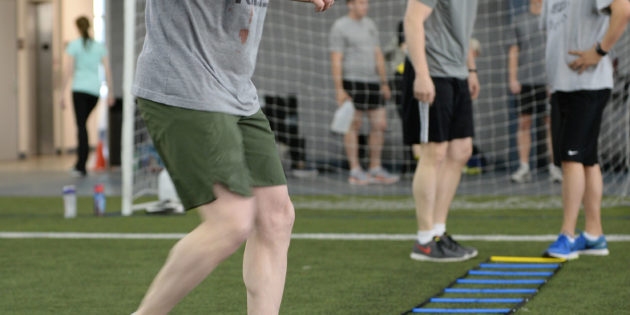Given the popularity of speed & agility ladders, I’m sure you’ve seen or used one at some point. And I’m sure you were told it would help you (or your child) run faster or improve your agility. And now here comes the truth – agility ladders won’t help you do either. So, does that mean they are useless!? No, they are just misused. Like any other piece of equipment, the ladder can be a useful tool when used for the proper reasons.
MYTH – they improve your agility
Let’s first define what agility is in the sports world. While there’s no set definition of agility, we can describe it a few different ways – it’s the ability to quickly change body position or the ability to start in one direction, stop, and start again in another direction; and there must be an unpredictability/reactive component to it. If you think about how your body moves during ladder drills, it doesn’t actually change position – your center of mass doesn’t move much, it’s usually pointed in the same direction and your feet just move underneath you. And a ladder drill is a pre-planned, set pattern – there is no external stimulus or reactive component to it. One improves their agility through practicing their actual sport against an opponent. This environment has an unpredictability and reactive aspect to it.
MYTH – they help you run faster
Most people who use agility ladders claim that they increase running speed by increasing your foot speed and, in fact, foot speed has nothing to do with actual running speed (otherwise tap-dancers would be the fastest people in the world). To run faster, you need to do at least one of the following three things: put more force into the ground (get stronger), increase your stride frequency, or increase your stride length. When doing agility ladder drills, you’re simply placing your feet in squares on the ground, you’re not actually putting any force into the ground.
What do they help with then and how should they be used?
Primarily, they serve as an effective part of a dynamic warm-up – especially for kids as it gets them to focus on something and keep their interest while moving around. Agility ladders can improve foot-eye awareness and help you learn how to maintain control of your body/center of mass. If you lean too far forward/backward/sideways during a drill, you will probably trip over your feet. In the training setting, they should be used as a part (about 5 minutes max) of a dynamic warm-up. You don’t have to use it all the time, just mix it in every once in a while to add some variety to your warm-up. In the rehab setting, it can be used to improve foot-eye awareness and get the patient used to different foot contacts with the ground or, again, as part of a dynamic warm-up. Usually I use it for patients when I feel like they are getting a little bored with their rehab program and need a change of pace (no pun intended) – I’m willing to use it for 5 minutes to spark their interest (especially with kids), even though it’s probably not doing that much for them.
Maybe we should just call them warm-up ladders and all this confusion would be resolved.
